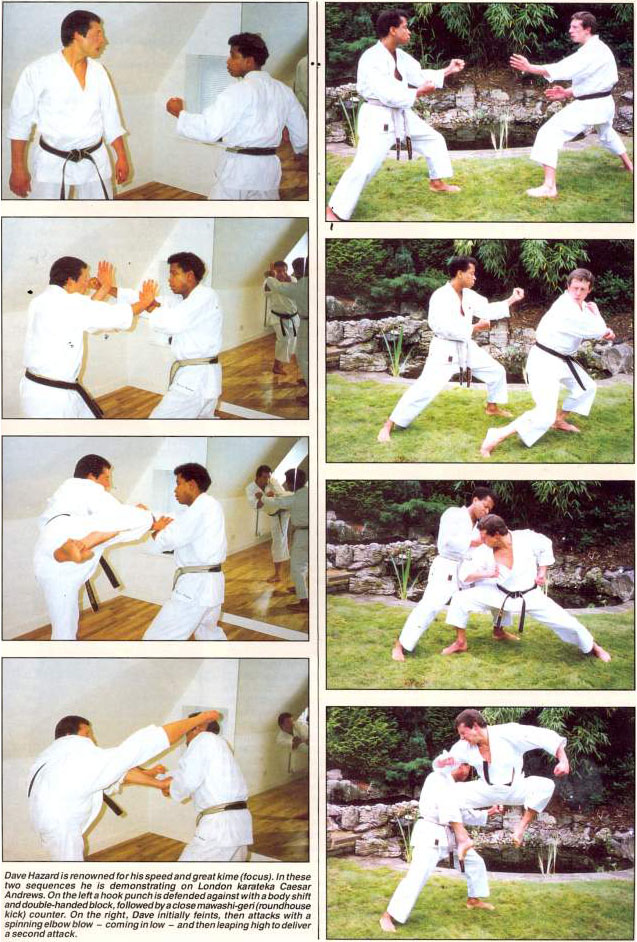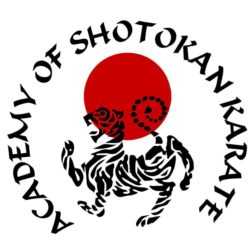Fighting Arts International
1988 Issue 49
The name Hazard is well known in the British Shotokan Karate World. A London protege of Master Enoeda, Dave earned a reputation as a very determined and dynamic karate-ka. He won several titles in both kumite and kata and was a member of the Karate Union of Great Britain’s (KUGB) National Team.
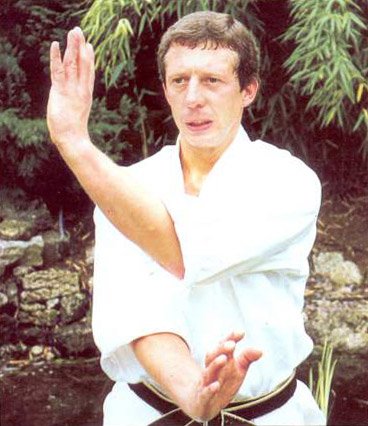
He went to Japan in 1977 where he trained in the famous JKA Instructors Class. Since returning to Great Britain he has become the technical director of the South East Karate Union (SEKU).
A professional instructor, he is based in Brighton, where he runs a very successful dojo. He also teaches karate nationally and internationally.
How did you first get into Karate?
I started off in judo in 1967 when I was still at school. I staed with judo for just on four years, I never reached any great proficiency but I took threee grades and it served as a good introduction to the martial arts. Then just by chance I heard about karate – I mean I’d heard rumours about kicking and chopping at the judo school but no one really knew anything about it in those days. A guy came in to the gents’ hairdressers where I was working with his hand all bandaged up and when I asked him about it he said he had done it practicing karate. Of course I followed up on that and the same week when I turned up at this hall in Blackfriars I watched a class of about a dozen students being taught by four Japanese… who turned out to be Enoeda Sensei, Kanazawa Sensei, Kato Sensei and Takahashi Sensei. And I just couldn’t believe them, I thought there were from the moon or something, I’d just never seen anything like it.
When I asked about joining, the guy who was in charge, Ray Fuller said “Yes, just come along on the next session”. He told me it was 50p to train, no membership was needed and to just put a tracksuit on and “Have a go”. The first class I ever took was quite unusual as it happened. There was only one instructor there this time – Kato Sensei – apparantly the first time I went was on a special night when they were all in attendance. I didn’t have to wear a tracksuit as someone had loaned me a karate-gi so I just got in the line. Well Kato Sensei stood us all in something resembling a front stance and as was the Japanese way in those days, he proceeded to walk along the line and kick our legs to see how firm we were. Now I had no idea about the correct etiquette or anything else about karata so when he stood in front of me and asked “Strong?” I just said “Yes”. No ‘Sensei’ or nothing. WIth that he swept my foot from under me, down I went and he started to walk away… Well where I came from, the East End, if anybody put you on your arse you let them have it. So I jumped up and took a swing at him. He obviously saw it coming and stopped me with a back kick. He then asked Fuller what was wrong with me and he explained that it was just my first night and I didn’t know any better. Quite an introduction to karate, don’t you agree?
That’s a funny story. You were obviously not the quiet type then?
No, I guess I was a bit of a ‘scrapper’, I rarely won but I’d always ‘have a go’. Anyway it only took about size classes and I got ‘the bug’. I was really hungry to learn and so I was quite irate when one evening I turned up and was told that I couldn’t go on the floor as there was a grading scheduled. I asked what that was and Ray Fuller told me that you just went out there and demonstrated what you’d been taught. So I said ‘OK, I want to do it”. He said “Please yourself” and charged me an extra 50p. When it came to my turn, there I was in front of Enoeda Sensei and Kato Sensei after only a handful of sessions. I expect my basics and sparring were terrible but the best was yet to come… on the kata I just went completely blank. Then I remembered that Ray had told us that there were twenty-one moves in ‘heian shodan’. I also remembered how much time he’d spent trying to teach us the knife-hand block. I put two and two together and so I did do twenty-one steps – all of them knife-hand blocks and somehow I managed to end up facing the correct way at the end. I remember Enoeda Sensei put his head down, said “Disgusting, get off”, and gave me temporary 9th kyu. So I got a few nasty shocks in the beginning.
I then started going to the Budokwai for classes because the Japanese were also teaching their at the time. Soon I was training nearly every night and I began something that I have continued right through my karate training; keeping record, documenting everything I have been taught and practiced. Not every single technique but the main points.
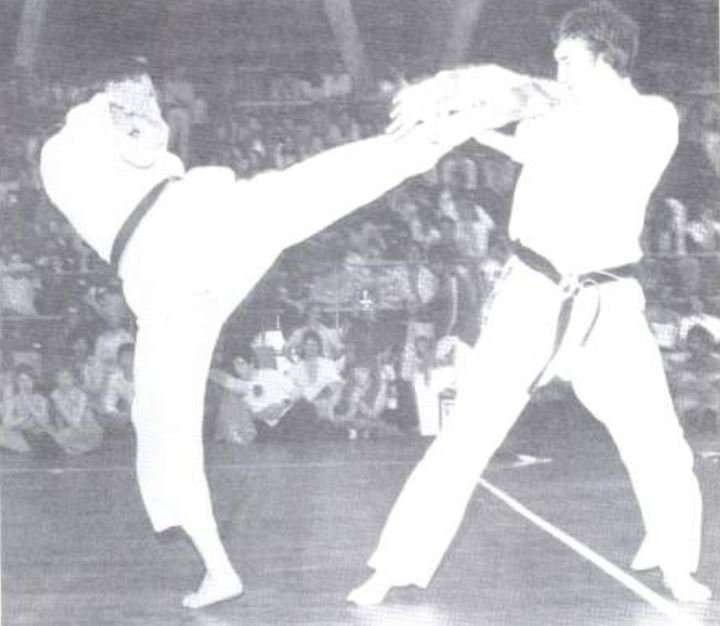
Dave Hazard in action in the
KUGB Championships
Really… you are only the second person that I know who has done that. Bill Christall, one of my old ‘Red Triangle’ colleagues has a similar record of all his classes… I only wish I had thought of it. Please continue – when did you get your shodan and when did you start competing?
I got my black belt on December 21st 1972 under Enoeda Sensei at the Blackfriars dojo. I had a little dabble at competitions as a green belt in the London ‘C’ team, I think it was – Budokwai and Blackfriars used to get together on teams at that time. Then I didn’t do much else until I was 1st kyu and I started entering the KUGB Southern Region Championships.
I had my first successes in these championships – I was the runner-up in the kata event and got through to the quarter-finals of the kumite. When the next one came around I was pretty confident that I would give everyone a run for their money. Some of the ‘big boys’ were either going rusty or else I was catching them up a bit. I won the kata and reached the final of the kumite where I met Terry Irvine… do you remember him?
Yes, of course I do.
Well, I’d been watching him fight all day, I knew me and I was pretty confident that I would win, too ‘cocky’ I guess because he got me with a great Mawashi-geri which knocked me right underneath the timekeepers’ table. I jumped up banging my head on the way and stood there, Enoeda Sensei, who was refereeing asked me “Alright?” I said I was, although I certainly didn’t feel it and he awarded an Ippon for the technique. So that was a good experience for me – a ‘leveller’.
The following year I had my best success in the Southern’s, being on the winning team and winning the individual kumite and kata… that was in 1975 I think. I was a finaliist in the Nationals’ several times and then won the kata in 1976. I got through to the final of the kumite that same year but then after what I felt had been a really good day of fighting for me, I had a realy disappointing match against Bob Poynton.
Yes, I remember that. You had fought really well, what happened, were you overawed by Bob?
No it wasnt that, I had respect for him of course, for all my seniors but I was never overawed by anyone. You only have one chance and so do they. No what happened was that I was advised not to kick. The person who told me that obviously thought I’d just get picked off if I did kick but l ended up just not putting up a good fight at all.
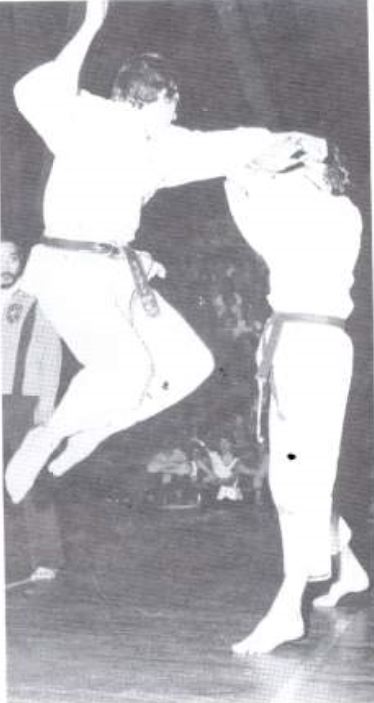
KUGB Championships
You were always very sharp and a quite nervy fighter weren’t you?
Yes… I’m not a big person (5’8″ and 168 lbs) and my asset was always speed. I have always tried to use my nervous tension and reaction in such a way so as to channel it to my advantage. Enoeda Sensei was of course my main influence but then there were many people who tried to emulate to some degree. I mean, I wanted Terry O’Neill’s legs, Andy Sherry’s gyaku tsuki, Bob Poynton’s mae-geri, Steve Cattle’s cunning. I had to try and steal them and incorporae them into my frame. Enoeda Sensei told me that when I got to Japan I should try to copy the way Yahara Sensei moved as we were of similar body size and and he was an extremely dynamic fighter. And this was very good advice. In fact many things that Sensei said to me that I didn’t really take in at the time have proved true as time has gone by — he is really very astute.
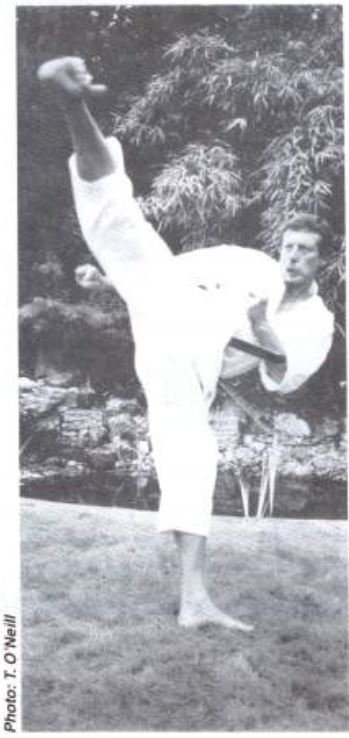
Let’s hear about your trip to Japan.
Well I went with a good friend of mine, Ray Kerridge, in fact he had the idea at first and I just tagged along. We just showed up at the JKA with a letter of introduction from Enoeda Sensei. So we were just in the normal classes for a week or so and then Kon Sensei, whom you’ll remember from the Crystal Palace courses came to the dojo and recognised us as students of his pal Enoeda Sensei. He suggested to them that we should be in the instructors class and so we got in that way. You can’t just go into the JKA Instructor Class, it’s by invitation only.
Of course having heard the stories about this training we were basically terrified, as everyone probably is at first. And they were quite rough but not in a bullying way and they give it to their own as well as you. They never picked you out as a gaijin (foreigner) for any special treatment. All the kenshusei (student instructors) got the same ‘attention’. The training methods were simple and basic but very gruelling and very very precise. They trained everyday, a minimum of one class, so they had the time you see, to spend on every detail. And if you were gaijin on the instructors class you also had to do the international class. You couldn’t miss a training class, if you were ill, you turned up anyway and sat on the sidelines.
How long is each class?
If it’s a morning class, it’s an hour. Afternoon classes sometimes last two hours. The international class is always for an hour and a half and you get a different instructor everyday. Some of the instructors were good – really tried to teach you – and others didn’t seem to give a hoot, you just got on with your work. Basically this class was no better than a regular class over here, apart from having a ‘star’ in front that you could try and emulate.
What about the instructors class… how did they differ?
Oh, the teaching was incredible, especially when Master Nakayama took the lesson. Apart from his very obvious skill, what amazed me about him was the way he could look at you and instantly feel off four or five things that you could improve your whole technique. He instinctively knew what you were doing wrong and could tell you precisely what corrections you needed to make. He was incredible in that respect.
Did Nakayama Sensei take many of these classes?
Yes… I took about 78 Instructors’ Classes – sometimes I doubled up and took two classes – but I have 78 days of instructors classes listed in my notes and Master Nakayama took over 50 of them. If it wasn’t him, it would be Shoji Sensei or Ueki Sensei and on odd occasion, Kanazawa Sensei. They would now and again get a slightly less senior instructor like Tanaka Sensei or Oishi Sensei to teach his favourite technique.
What caliber instructors were in the classes when you were there?
Well, with the exception of Master Nakayama, if they weren’t taking the class they would be in it. In addition there was Abe Sensei, Tabata Sensei, Yahara Sensei, Mori Sensei, Isaka Sensei, Osaka Sensei, Sato Sensei – who still carried the marks of Yano Sensei, two permanent black eyes from all the batterings he got from him, plus lot of kenshusei like Kawawada.
Was the sparring very fierce?
A lot ot ju-ippon kumiite (semi-free sparring) at first and then this would change to dojo kumite which was far removed from anything I had done before. You didn’t go quite at full speed but you never stopped either. There are no illegal targets or illegal techniques which made it quite ‘interesting’ let’s say!
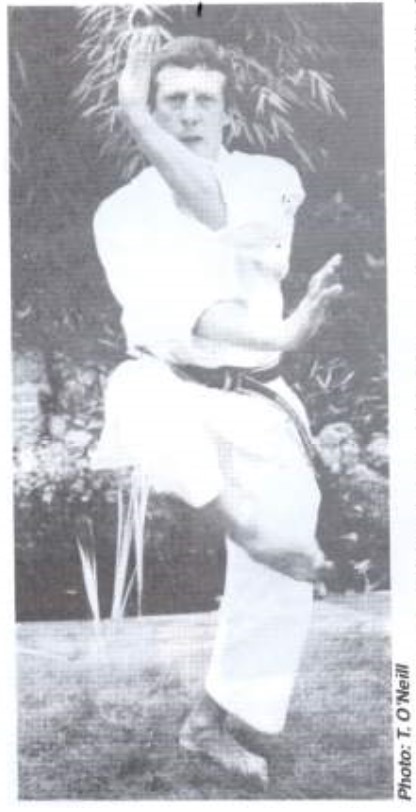
So you could do anything?
Yes, virtually, you had to keep it as clean and as big and full a technique as possible but once you had completed those, you didn’t stop and if you could ashi barai your opponent you followed him down to the floor and perhaps put a neck lock on him. Yehara Sensei would elbow you in the groin or bite you after he took you down, He’d try anything and everything, really incredible. Sometimes he let you take him down so he could try and combat you from the floor, else he’d sweep you and then just stand there to encourage you to greb his legs, so he could try something else he was thinking of. He once fought me for 45 minutes solid.
Did you feel a marked improvement from your training in Japan?
Yes, very much so. They taught me to think what went on between the start and the finish of a technique, the interim motion or movement was gone into in a lot more depth. Also the gaining of momentum — how to maximise momentum through the correct use of the muscles. l’d say the two most crucial things I learnt in Japan was the body mechanics of the techniques — to make the body perform right and the other side — how to feel when you are doing them, the attitude.
How did your attitude change? I mean we have heard how, on your first karate lesson, you attacked the Sensei…
The training in Japan gave me the ability to have the confidence of not always hitting with 100% of what I had… to the point where I could decide whether to ‘do you’ a little bit or ‘do you’ a lot. They allowed me to be more expressive which I feel is reflected in the way I now teach karate, I like my students to question me at the end of the class if they haven’t understood something or if they can’t get it to work, I tell them not to just trust me but to think for themselves. To try and find out what will work best for their bodies. I try to teach the best possible usage of what they have got but of course you can’t do that with every individual in a class.
I have spoken to quite a number of instructors that have had you to their clubs for a course and they all give you an excellent ‘write-up’ — Why is this . . any idea?
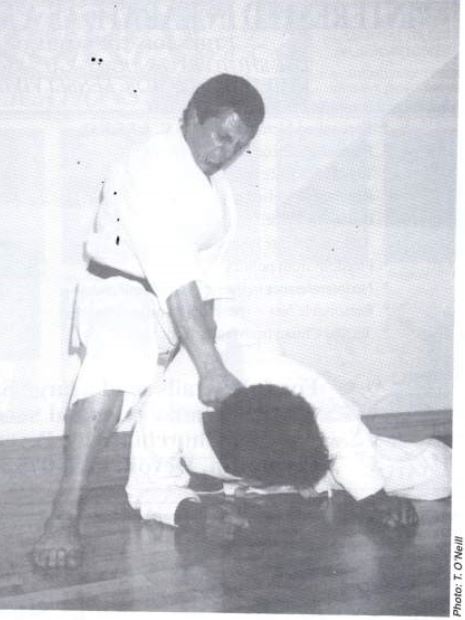
I’d like to think it was communication. If I have a group ot people in front of me, no matter how good or bad they may be, as long as they are prepared to ‘work’ I get terribly inspired and make it work for them. l get a real ‘buzz’ out of seeing students improve.
How much of the tough JKA type training that you underwent has rebounded on the students that you now teach?
I don’t think I beat them up, some of my students may say different but I do realise that to make it work they have to work, but I don’t think I’m brutal in the dojo. There may be a little bit of contact there but that’s only with the students who want to ‘get in’ on that ‘bag’, But if a student comes along and just wants to learn karate as some do, then I teach them as technically correct as I can and I show them what IS available to them and say ‘do you want it or not?’ and go through that door and they want it, I’ll let them have it. Not let them ‘have it’ physically but show them what we have got to do to make it purposeful, to make it work.
So you differentiate the levels at which you teach students?
Oh yes, of course. I have got different classes in my club, and different levels of students. The way I teach my own club, as is probably the case with all professional teachers, is different to the way I teach on courses – I try to go to a course maybe with an idea or a concept, never a pre-conceived class and by the time have done two or three techniques I have seen what I want to do. Because they tell me, just with their body movements or in something they can’t do and I can build a class around that very easily.
Travelling around teaching all over the country — what do you think is
the weakest aspect of karate over here?
Attitude and etiquette, I mean you will always get a certain amount of people who just can’t do the physical techniques anyway, no matter how hard you teach them, their bodies are limited. All you can do in these cases is get them as correct as you can and try to show them the best way for them to perform a particular thing. So many people come and tell me ‘Sensei I can’t do a side-kick because it hurts my body’. There’s not a technique in karate that I have found that, if done correctly hurts your body. The only thing that hurts your body technically in karate is bad technique. Mechanically the techniques are designed perfectly I think.
But to me the most important thing is to have a correct karate attitude and etiquette. And I think one seems to breed the other. If the attitude is strong so usually is the etiquette.
Another problem is mis-informed exaggerations of what the Japanese taught when they first came over. These are just little things, mistakes that I also made before going to Japan but which annoy me since I have been over there.
In Japan when you enter the dojo you dont say ‘Oss’ you just bow – And it’s how you say the word. A lot of people over here just hiss at each other. Now I’m not a snake and neither is my opponent. The word is a large ‘O’ and two small S’s. If you are going to use it you have to pronounce it correctly — it’s part of your art. Bowing incorrectly. from heisoku dachi (informal attention stance – feet together) instead of musubi dachi (informal attention stance — toes turned outward). If you are in the army or the air force you salute correctly — there is a performance in doing it. If a superior officer went past and you just lifted your hand any old way, you’d be on a charge. When you bow in karate you should do it correctly. If you have an opponent you should bow at the same time with eye contact. It’s like a small contract if you like – I’m going to pressure you, use clean, hard, sharp techniques and try to win. So you fight but you show each other a bit of respect. If I dared, in the Instructors Class, to bow before my senior or late then I ‘got it’. I had to wait, get eye-contact, then when he started to bow. I bowed too… that was the way it had to be done. And you had to try your best
when you were sparring with them. The worst thing you could do was to back off scared — if you did that you’d really cop it.
Didn’t you back off at all?
Of course I did – a couple of times at first, through fear and anguish and through not knowing, I got a real good bang off Tanaka Sensei for doing this. I was running away too quick — you’re supposed to retreat at the correct pace it was a five attack sequence from freestyle position — any attack and you had to block and counter the last attack. Well all I done was really back-pedal and never gave him a chance to get a clean technique anywhere near or even do his work — so neither of us were winning. So it got to the last technique and he made sure he cornered me up and he hit me with teisho (palm-heel), bang, straight in the middle of the forehead. When I got up he said “Do you know what I hit you with?” I said “No Sensei”… He said “Teisho … if seiken (first) you would be finished now! And I done that because of attitude. More shiai, more zanshin (awareness)”. And that was that, it taught me a lesson and I tried harder against him next time and I didnt get hurt at all. Some of the seniors were heavy on their contact but, it was never really brutal. There was of course accidents — I got my ribs broke, a finger here and there, silly little things. Now first three times you are hurt enough to go to see a doctor, if you are in the Instructors Class you are privileged and they pay for you. But after that you pay for your own treatment and after my third time — it was an injury to my ribs, courtesy of Iida Sensei and he was very apologetic. It was my fault — I was moving in at the wrong time and he was making a very good kick, a mae-geri. When I got back to the dojo. Omura who was a Kenshusei when I was there, said “How many times go to doctor now?”, “This was my third” I said. He laughed and rubbing his hands together said “Next time you pay — yes?” I thought better get good today, because treatment is expensive over here!
Did you have to take time off from the dojo with injuries?
No, if you were away from the class you were ‘for it’. When I left the class to be with the KUGB squad, when you were all over in 1977 for the World Championships, when I went back I got a beating. And I had asked could I go, they said ‘Yes, certainly’. Another time they knew I had to go to the immigration department about my visa. I had a letter from the JKA asking if I could stay in Japan as was in their premier class. Everyone knew I was going, Master Nakayama signed the letter — I still have it at home. I went there and it took a full day. When I went into the class the next day got ‘pushed’ around quite heavily because I had missed a days training! Now they knew exactly where I was going but that’s just their mentality, their way. Someone was missing and it had to be seen by everyone because some of the others in the class might not have known I had gone to get a visa extended. But it wasn’t too bad, I was still able to train the next day.
Looking back, how did the whole Japan experience affect your karate?
More when I returned — it took some time to digest it all. When I came back — you’ll probably remember, I lost a lot of weight and I was even more ‘nervy’ than I’d been before — I felt sort of ‘shell-shocked’. I was living really on my nerves and it took me quite a long time to unwind. To wake up in the morning and realise that I didnt have to go training… I was very jittery and I used to have to go out for little runs to sort of ‘gear down’.
It wasn’t until as long as a year after I’d got back, before started putting together a lot of things I had learnt and experienced over there. At that time I was training with Kawazoe Sensei — he had invited me to his dojo. To me it seemed as though they had given me a sort of jigsaw in Japan and it was only after I had distanced myself from it that I was able to start putting the pieces together.
Are you still enjoving your karate as much as you did?
More than ever at the moment. It’s basically because now I’m more settled. I did go through a quite disturbing period after I got back from Japan.
Is that when you lett the KUGB?
It wasn’t a case of leaving, I never actually left the KUGB, nor was I asked to leave, it was just something that sort of evolved. When I left Great Britain for Japan I was a member of the squad. By the time I got back my licence had expired, Then I had a disagreement with Enoeda Sensei — a personal conflict, nothing technical and I felt a little bit ‘out in the cold’. But that is all way in the past now, I still have as much respect for Enoeda Sensei as I have ever had and I am still in regular contact with him. I inform him of everything I do and ask his opinion, not necessarily his permission but his views and always take these into consideration. I probably have a better relationship with him now than I have ever had.
I was given a great opportunity in 1984 by Mick Dewey who is a close friend at mine and my senior in karate. He has always been a source of inspiration to me and this is not just bull, for the tape, I have never met a more sincere or more dedicated person to his karate. Mick had formed SEKU, (the South East Karate Union) around 1982 and he asked me if I would like to join forces with him and help build the organisation. Now at that time I’d been out in the wilderness, so to speak, or about two years — not connected directly with anybody. I’d began teaching more and more as various clubs up and down the country invited me to hold courses for them. I enjoyed it and they seemed to enjoy the training and I’d always wanted to make karate my profession. In the end I was getting a great deal of work. So I was very happy to Join Mick and I’d been with him for nearly 2 years, going around all their dojos, when they gave me the honour of making me technical director of SEKU — which is a position I’m very conscious of, I formed an instructors class, based on the JKA instructors Class but less frequent of course. We only do it once a month, one Sunday in four from 10am to 5pm. What we do is a couple of hours in the dojo, then we have a break and talk about karate, have some rice or something, you know make it sort of traditional. And then we go back into the dojo for some more. It’s educational more than a ‘killing’ session. It’s invitation only now — when we first started off we said any 3rd dans in the organisation were eligible and could come along and see if they wanted in. Quite a few came and tried it, then said it wasn’t for them. After a while we had got our main core and now we only invite people we see coming up who we think have got the potential to benefit from the classes. Going on from there, Mick suggested it would be a good idea if I got a dojo ofmy own, a base. I agreed and sad that I’d open and develop a dojo in any area that SEKU did not already have one in. Now at that time I was teaching regularly at the Brighton Shotokan Club which was with SEKU and they upon hearing of my intention to start a dojo somewhere offered me their dojo. They were a very well-established club,former members of the KUGB and had been going for 11 years. However the three 3rd dans who ran the club were more interested in training rather than teaching and they ware all very keen for me to take it over. Of course I agreed, it was a great opponunity for me to walk into a ready-made good club.
Are there any points that you ‘d like to comment on that I neglected to ask you about?
Only I seem to have been ‘mis-quoted’ in some quarters and here I am referring to things that I’m supposed to have said whilst teaching. People will often read into a comment more than what is really there — you know that, I’m sure. I have always said that if what I teach is different to what somebody else has done before or after me, it doesn’t mean that I’m right and the other instructor is wrong, or vice versa. It’s just another way of doing it, a different concept. I have never ‘knocked’ other instructors. Everyone has something to offer. I think it is idiotic when people say ‘No, that’s no good, it doesn’t work’, it works for the people teaching it and it could work tor you if you give it half a chance. There are so many styles and arts, and some appear to contradict each other but that contradiction doesn’t make one work and one not work. Tai chi is very fluid and soft but it’s still practical, it still works when it is applied the way it should be. So who can say that that is wrong and the hard way is right? Everything works as long as you do it in that concept — as long as you are committed to that movement.
What’s the strongest part of Dave Hazard ‘s karate?
I want to win. Commitment… spirit.
Any advice you’d like to pass on?
Dont just do it, think about it, try to encourage students to spend just 10 minutes of their day — apart from their dojo time, thinking karate. If they can do that on a regular basis they can easily spread that to 15 minutes and so on until they are living their karate day in and day out. I disagree with the concept that karate is a ‘way of life’. I’d rather translate the do’ as a vehicle rather than a ‘way’. I think that would be more appropriate to a Westerner — the Japanese culture is different to ours. Enoeda Sensei told me ‘Family first, job second, Karate-do’. To me karate is a vehicle that takes me through life.
